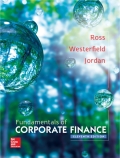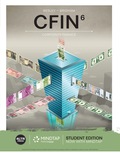
Dividends versus Reinvestment [LO2] After completing its capital spending for the year, Carlson Manufacturing has $1,000 extra cash. Carlson’s managers must choose between investing the cash in Treasury bonds that yield 3 percent or paying the cash out to investors who would invest in the bonds themselves.
a. If the corporate tax rate is 35 percent, what personal tax rate would make the investors equally willing to receive the dividend or to let Carlson invest the money?
b. Is the answer to (a) reasonable? Why or why not?
c. Suppose the only investment choice is a
a)
To determine: The personal tax rate.
Introduction:
C manufacturing company has 1000 extra cash. The managers decide to invest the cash in treasury bills that yield 3% or to pay the cash out to the investors.
Answer to Problem 16QP
Explanation of Solution
Given information:
The corporate tax rate is 35%.
Determine the personal tax rate:
Note: Consider the tax rate as ‘
Compute the individual after-tax dividend:
Therefore, the after-tax dividend can be invested in treasury bonds.
Compute the after-tax cash flow from treasury bonds:
Note: Let this be equation 1.
Compute the proceeds if the firm invests the money:
Compute the proceeds if the firm pays dividend:
Note: Let this be equation 2.
Whether the investors invest the after-tax dividend or receive the proceeds from the firm’s investment, the investors’ proceeds will be the same.
Solve these two equations to find the rate of indifference.
Therefore, the personal tax rate that makes the investors equally and fairly willing to obtain the dividend or C to invest money is 35%
b)
To discuss: Whether the above solution is reasonable or not.
Explanation of Solution
Yes, the above solution is reasonable.
Person C is indifferent if the after-tax proceeds from the $1,000 investments in the securities are identical. The above indifference occurs only when the tax rates are identical.
c)
To determine: The personal tax rate.
Answer to Problem 16QP
Explanation of Solution
Given information:
The preferred stocks yield at 6%, seventy percentage of income is exempted from the corporate taxes, and person C gets more benefits by investing in stocks.
Compute the personal tax rate:
The same answer in part (a) will apply to this, as the pretax returns are the same.
The seventy percentage of income is exempted from the corporate taxes and Person C gets more benefits by investing in stocks.
The rate of tax on income, which includes indifference, is lower.
Solve the equations to get the value of personal tax rate.
Derived equation: 1
Derived equation: 2
Note:
Corporate tax percentage is 35%
Find
Hence, the rate of personal tax is 10.50%.
d)
To discuss: The reason whether a low dividend payout ratio has a compelling argument or not
Explanation of Solution
Yes, the low dividend payout ratio has a compelling argument and it has some legal constraints, which restricts the firms from investing their money in the stocks of other companies.
Want to see more full solutions like this?
Chapter 17 Solutions
Fundamentals of Corporate Finance
- Low default risk is a characteristic of money market securities. Question 6 options: True Falsearrow_forwardJeep Corp. held large sums of cash during the mid-1990s primarily because it would need a large amount of cash in the event of a recession. This is a[n] _____ for holding cash. Question 5 options: Adjustment motive. Compensating balances motive. Speculative motive. Transactions motive. Precautionary motive.arrow_forwardWith respect to the workings of a lockbox system, the cheque clearing process begins before the company even knows the payments have been received. Question 4 options: True Falsearrow_forward
- You are considering implementing a lockbox system for your firm. The system is expected to reduce the collection time by 1.5 days. On an average day, your firm receives 250 checks with an average value of $400 each. The daily interest rate on Treasury bills is .02%. What is the anticipated amount of the daily savings if this system is implemented? Question 3 options: $30 $25 $15 $20 $10arrow_forwardDisbursement float is virtually eliminated when payments are made electronically. Question 2 options: True Falsearrow_forwardAccording to your cheque book, you have a $3,000 balance in your account. You write cheques totaling $4,500 and make a deposit of $3,500. Determine your net float. Question 1 options: $8,000 -$1,000 $0 $1,000 $4,000arrow_forward
- What is a blue-chip stock? a) A stock with high volatilityb) A stock of a well-established, financially sound companyc) A newly launched IPO stockd) A stock with high dividends but low growtharrow_forwardNo chatgpt! What does “liquidity” refer to in finance? a) The profitability of a companyb) The ease of converting assets into cashc) The stability of incomed) The level of debtarrow_forwardNeed help!! What does “liquidity” refer to in finance? a) The profitability of a companyb) The ease of converting assets into cashc) The stability of incomed) The level of debtarrow_forward
- I need help ! What does “liquidity” refer to in finance? a) The profitability of a companyb) The ease of converting assets into cashc) The stability of incomed) The level of debtarrow_forwardWhat does “liquidity” refer to in finance? a) The profitability of a companyb) The ease of converting assets into cashc) The stability of incomed) The level of debtarrow_forwardWhich of the following is considered a long-term source of finance for a business? A) Trade credit B) Short-term bank loan C) Issue of shares D) Overdraftarrow_forward
 EBK CONTEMPORARY FINANCIAL MANAGEMENTFinanceISBN:9781337514835Author:MOYERPublisher:CENGAGE LEARNING - CONSIGNMENT
EBK CONTEMPORARY FINANCIAL MANAGEMENTFinanceISBN:9781337514835Author:MOYERPublisher:CENGAGE LEARNING - CONSIGNMENT Intermediate Financial Management (MindTap Course...FinanceISBN:9781337395083Author:Eugene F. Brigham, Phillip R. DavesPublisher:Cengage Learning
Intermediate Financial Management (MindTap Course...FinanceISBN:9781337395083Author:Eugene F. Brigham, Phillip R. DavesPublisher:Cengage Learning




